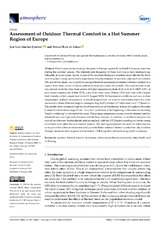Mostrar el registro sencillo del ítem
Assessment of outdoor thermal comfort in a hot summer region of Europe
| dc.contributor.author | Sánchez-Jiménez, J.L. | |
| dc.contributor.author | Ruiz de Adana, Manuel | |
| dc.date.accessioned | 2024-02-13T10:55:54Z | |
| dc.date.available | 2024-02-13T10:55:54Z | |
| dc.date.issued | 2024 | |
| dc.identifier.issn | 2073-4433 | |
| dc.identifier.uri | http://hdl.handle.net/10396/27454 | |
| dc.description.abstract | Heat waves are increasingly frequent in Europe, especially in South European countries during the summer season. The intensity and frequency of these heat waves have increased significantly in recent years. Spain, as one of the southern European countries most affected by these recurring heat waves, particularly experiences this phenomenon in touristic cities such as Cordoba. The aim of this study was to perform an experimental assessment of outdoor thermal comfort in a typical three-hour tourist walkable path of the historical center of Cordoba. The experimental study was carried out in the three-hour period of higher temperatures from 16:30 to 19:30 h CEST (UTC+2) on a normal summer day (6 July 2023), a day with a heat wave (28 June 2023) and a day with a higher heat intensity, called a super heat wave (10 August 2023). Environmental conditions such as a radiant temperature, ambient temperature, wet bulb temperature, air velocity and relative humidity were measured at three different heights corresponding to 0.1 (ankles), 0.7 (abdomen) and 1.7 (head) m. The results show extremely high levels of heat stress in all bioclimatic indices throughout the route. Cumulative heat stress ranged from “very hot” conditions at the beginning of the route to becoming “highly sweltering” at the end of the route. The average temperature excess over the thermal comfort threshold was very high and increased with the heat intensity. In addition, a correlation analysis was carried out between the bioclimatic indices studied, with the UTCI index standing out for its strong correlation with other thermal comfort indices. The findings emphasize the need for interventions to improve the urban environment and promote better outdoor thermal comfort for city dwellers through measures such as green infrastructure, UHI mitigation and increasing public awareness. | es_ES |
| dc.format.mimetype | application/pdf | es_ES |
| dc.language.iso | eng | es_ES |
| dc.publisher | MDPI | es_ES |
| dc.rights | https://creativecommons.org/licenses/by/4.0/ | es_ES |
| dc.source | Atmosphere, 15(2), 214 (2024) | es_ES |
| dc.subject | Outdoor thermal comfort | es_ES |
| dc.subject | Heat stress | es_ES |
| dc.subject | Urban microclimate | es_ES |
| dc.subject | Sustainable cities | es_ES |
| dc.subject | Health and well-being | es_ES |
| dc.title | Assessment of outdoor thermal comfort in a hot summer region of Europe | es_ES |
| dc.type | info:eu-repo/semantics/article | es_ES |
| dc.relation.publisherversion | https://doi.org/10.3390/atmos15020214 | es_ES |
| dc.relation.projectID | Gobierno de España. RTI2018-094703-B-I00 | es_ES |
| dc.rights.accessRights | info:eu-repo/semantics/openAccess | es_ES |

